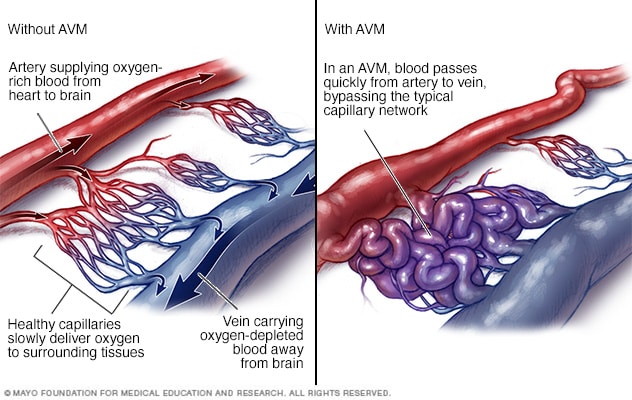रक्तस्रावी आघात किसे कहते हैं ?
जब हमारे दिमाग की कोई रक्तवाहिका में या तो रिसाव होने लगे या फिर वह किसी वजह से फट जाए (इसकी वजह देर से चला आ रहा उच्चरक्त चाप भी हो सकता है )तब इस प्रकार मस्तिष्क के अंदर होने वाले रक्तस्राव को रक्तस्रावी आघात कहा जाता है।
इसकी अनेक वजह सामने आईं हैं :
(१ )अनियमित (बेकाबू )रहा आया उच्चरक्तचाप (Uncontrolled Hypertension )
( २ )थक्का घुलाने वाली दवाओं (Blood thinners )का बेहद का और अतिरिक्त सेवन
(3 )रक्तवाहिकाओं के भीतरी असतर में कमज़ोर स्थलों का होना।
इसे aneurysms कहा जाता है।
An aneurysm occurs when an artery's wall weakens and causes an abnormally large bulge. This bulge can rupture and cause internal bleeding. Although an ...
An aneurysm occurs when part of an artery wall weakens, allowing it to balloon out or widen abnormally. The causes of aneurysms are sometimes unknown. Some may be congenital, meaning a person is born with them. Aortic disease or an injury may also cause an aneurysm.
A less common cause of hemorrhage is the rupture of an abnormal tangle of thin-walled blood vessels (arteriovenous malformation).
रक्तवाहिकाओं का परस्पर उलझना उलझाव इसकी वजह बनता है।
जब हमारे दिमाग की कोई रक्तवाहिका में या तो रिसाव होने लगे या फिर वह किसी वजह से फट जाए (इसकी वजह देर से चला आ रहा उच्चरक्त चाप भी हो सकता है )तब इस प्रकार मस्तिष्क के अंदर होने वाले रक्तस्राव को रक्तस्रावी आघात कहा जाता है।
इसकी अनेक वजह सामने आईं हैं :
(१ )अनियमित (बेकाबू )रहा आया उच्चरक्तचाप (Uncontrolled Hypertension )
( २ )थक्का घुलाने वाली दवाओं (Blood thinners )का बेहद का और अतिरिक्त सेवन
(3 )रक्तवाहिकाओं के भीतरी असतर में कमज़ोर स्थलों का होना।
इसे aneurysms कहा जाता है।
An aneurysm occurs when an artery's wall weakens and causes an abnormally large bulge. This bulge can rupture and cause internal bleeding. Although an ...
An aneurysm occurs when part of an artery wall weakens, allowing it to balloon out or widen abnormally. The causes of aneurysms are sometimes unknown. Some may be congenital, meaning a person is born with them. Aortic disease or an injury may also cause an aneurysm.
A less common cause of hemorrhage is the rupture of an abnormal tangle of thin-walled blood vessels (arteriovenous malformation).
रक्तवाहिकाओं का परस्पर उलझना उलझाव इसकी वजह बनता है।
-
AVM blood flow
An arteriovenous malformation (AVM)
is
an abnormal tangle of blood vessels
connecting arteries and veins, which
disrupts normal blood flow and oxygen circulation.
Arteries are responsible for taking oxygen-rich blood from the
heart to the brain. Veins carry the oxygen-depleted blood
back to the lungs and heart.
When an AVM disrupts this critical process, the surrounding
tissues may not get enough oxygen, and the affected arteries
and veins can weaken and rupture. If the AVM is in the brain
and ruptures, it can cause bleeding in the brain
(hemorrhage),
stroke or brain damage.
An arteriovenous malformation can develop anywhere in your
body but occurs most often in the brain or spine.
रक्तस्रावी आघात की भी कई किस्में हैं
(१ )इंट्रासेरेब्रल हेमरिज :इस प्रकार के आघात में कोई एक
रक्तवाहिका आकस्मिक तौर पर फैट जाती है इसकी फटन और छिटकाव से
आसपास की दिमागी कोशिकाएं क्षतिग्रस्त हो जाती है। ऐसे में रिसाव से परे
जो कोशिकाएं हैं राकापूर्ति से वंचित रह जाती हैं अत :वह भी क्षतिग्रत हो
जाती हैं।
अनियमित बना रहा उच्चरक्त चाप ,किसी प्रकार का सदमा ,खून का पतला
रखने वाली दवाओं का अधिक इस्तेमाल तथा कई अनेक स्थितियों में भी यह
देखा जा सकता है यथा वैस्कुलर मॉलफार्मेशन के मामलों में।
Vascular malformation is a general term that includes
congenitalvascular anomalies of only veins, only lymph
vessels, both veins and lymph vessels, or both arteries and
veins. Only veins: venousmalformation (VM) Only lymph
vessels: lymphatic malformations(LM)

कोई टिप्पणी नहीं:
एक टिप्पणी भेजें